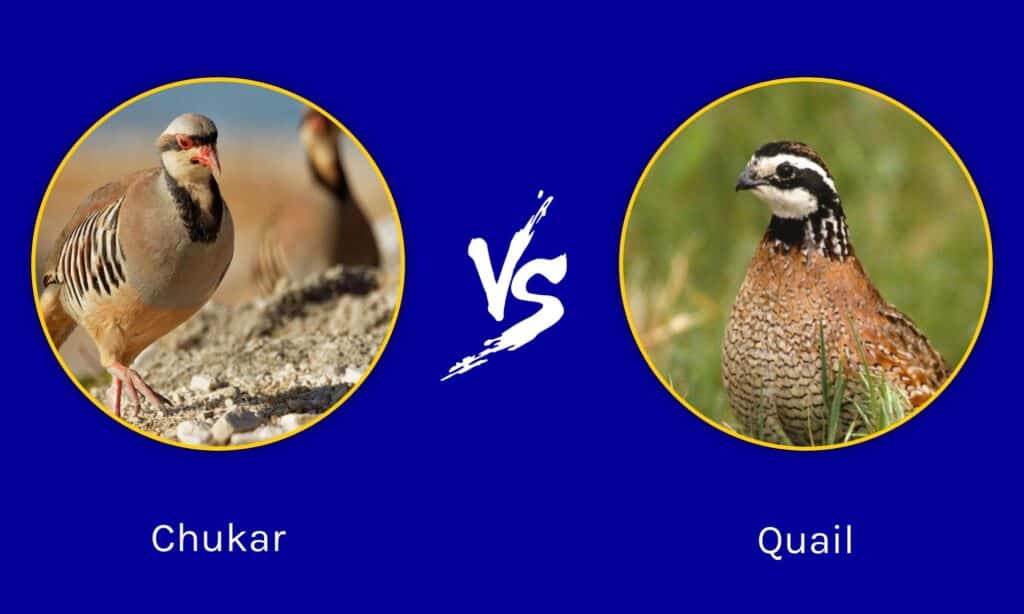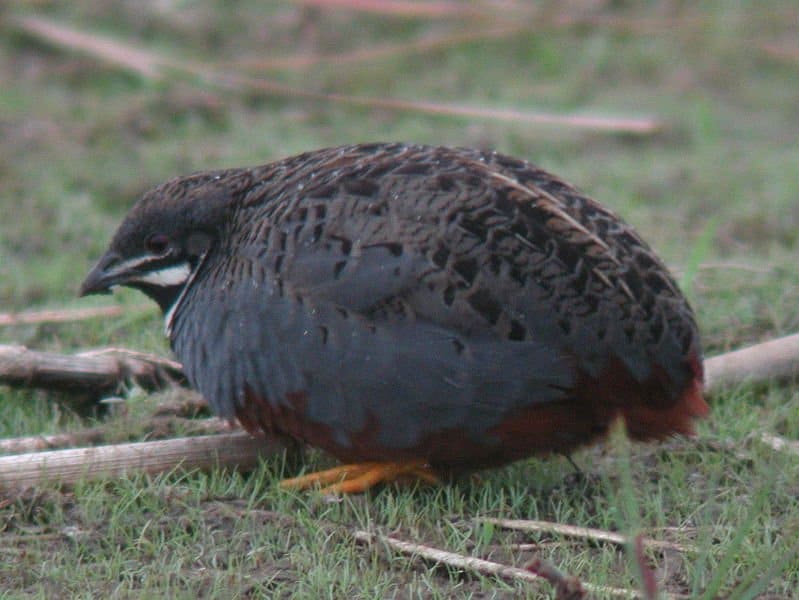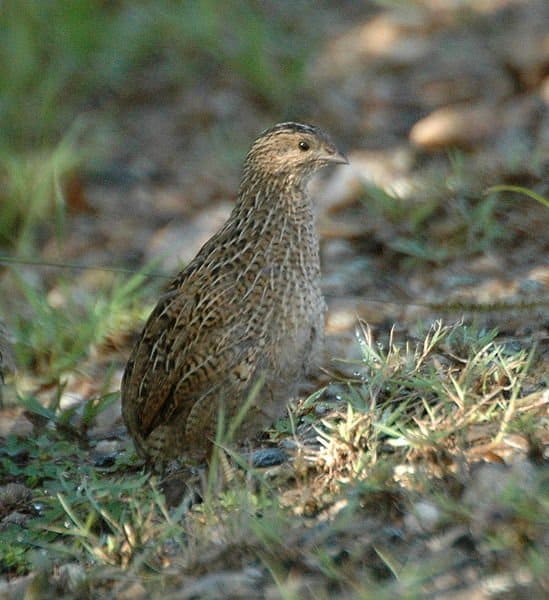The chukar partridge, or chukar/chakor for short, is a Palearctic upland gamebird in the Phasianidae family. This bird inhabits sections of the Middle East and Asia’s temperate regions. Alternatively, several genera of medium-sized birds are together referred to as quail, in the order Galliformes. Frequently, people wonder what the primary distinctions are between these two game birds. In this essay, we will reveal the differences between chukar vs. quail!
Chukar vs. Quail: A Comparison

| Key Differences | Chukar | Quail |
| Size | 13 to 14 inches Tall; Up to 20 oz | 5-7 Inches Tall; Up to 1lb |
| Colors | Gray-And-Brown Coat And A White-Striped, Black Face | White Stripes on Brown Flanks; Gray and Brown |
| Physical Features | Chubby Body; Small Round Head | Short, Stocky Body; Long Pointed Wings |
| Danger | Prey on Larger Birds/Animals; Males Can Attack Humans | Typically Docile; Sometimes Kept as Pets |
| Diet | Seeds, Grasses, Insects | Omnivore; Both Plants and Animals |
| Lifespan | 3 to 5 Years | 1 to 6 Years |
| Habitats | Middle East; Asia and China | Everywhere but Antarctica |
| Habits | Form Small Groups; Stay in Low Terrain Outside of Nesting | Congregate in Flocks; Fly up to 40 mph |
Key Differences Between Chukar vs. Quail

Quails eat insects, including ticks.
©iStock.com/twildlife
The key differences between a chukar and a quail are size, appearance, physical features, lifespan, habitat and habits.
Both quail and chukar are game birds, which means it is legal to hunt them in the U.S. according to certain laws. The quail is a little game bird with a short tail that is linked to chukar partridges through the families Phasianidae and Odontophoridae. The Alectoris chukar is a gallinaceous game bird related to pheasants, grouse, and quail. Let’s compare the chukar and the quail in further detail below!
Size
Adult quails weigh up to one pound and stand approximately between 5-7 inches in height. The chukar is a ground-dwelling bird that weighs approximately 20 ounces and reaches 14 to 15 inches in length.
Colors
Mountain quail has white stripes on brown sides and is primarily gray and rich brown, as opposed to sandy brown. Chukars are brown with black vertical bands. A dark ring around the cheek and throat via the eyes. A red bill and eye ring complete the look. Quails have a gray-and-brown coat and a white-striped, black face. Females have lighter skin and no scars. Both sexes have white, creamy, and chestnut bellies.
Physical Features
Quails, which are little birds, are related to pheasants and partridges. They have a characteristic body shape, consisting of a short, stocky body and long, pointed wings. Approximately 20 wild species of quail exist throughout the world, and approximately 70 kinds are domestic fowl.
Chukars resemble chickens in that they possess a chubby bodies and short, round heads. A black eyeliner that extends around the neck, a cream-colored neck, a red bill, and dramatic striping on the sides characterize this bird.
Danger
Even larger animals are prey for the chukar partridge. However, if spooked they will typically flee. Some male species attack larger birds, animals, and even humans with their spurs.
Although some quails are antagonistic, the majority are kind, easy to care for, full of character, and delightful to play with. Coturnix quails are good pets for this reason.
Diet
The quail is an omnivore, meaning it consumes both plants and animals. It mainly eats seeds and leafy greens. Chukars consume seeds, delicate fresh grasses, and shrubs, in addition to insects. Cheatgrass is prevalent throughout a substantial portion of the chukars’ territory, which is a major factor in their successful establishment.
Lifespan
Generally, quails make excellent pets and can generate healthy eggs and meat. They are strong, vigorous birds that can live up to six years and are simple to feed and care for. In the wild, rarely does a quail reach old age. Under one year is the average lifespan. The lifespan of chukars ranges between three and five years. However, once they hatch, these birds are vulnerable to a variety of threats as a species.
Habitat

Chukar resides throughout Middle East Asia and China.
©Martin Pelanek/Shutterstock.com
Chukars live in the Middle East, throughout Asia and China. They typically live in rough terrains and extremely wild habitats. These areas feature steep green valleys, rocky ledges, and talus slopes. At any time during the hot, dry summer and fall, you can find chukars congregating near bodies of water.
Apart from Antarctica, quail live all around the world in ecosystems that are surprisingly harsh and inhospitable. They prefer mountainous areas with rocky outcrops and desert margins. Most of the places they live are either semi-arid or desert, with little to no rain.
Habits
For most of their life, quail congregate in small flocks of eight to 25 individuals. Quail frequently flies at speeds between 30 and 40 mph. Once in the mornings and once in the evenings, quail forage. Chukars typically form small groups of no more than ten birds. Outside the nesting season, they live in green meadows and valleys in the lower reaches of the mountains.
Wrapping Up Chukar vs. Quail
The partridge’s flanks have distinct black-and-white bars, and its black-and-white eye-and-necklace necklace protects the white of its throat. There are no black stripes on the flanks of the mountain quail, which contrasts with the chukar’s white stripes on brown flanks. Chukars fly more efficiently than other birds of prey. People hunt both game birds for food. Chukar has a superior flavor to pheasant because of its larger size and ability to fly.
The photo featured at the top of this post is © Martin Pelanek/Shutterstock.com
Thank you for reading! Have some feedback for us? Contact the AZ Animals editorial team.








